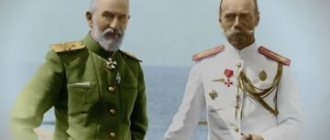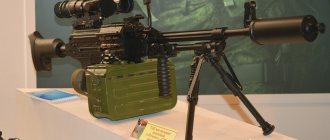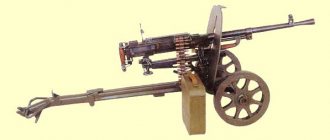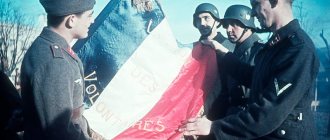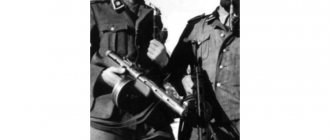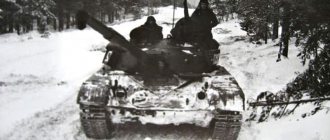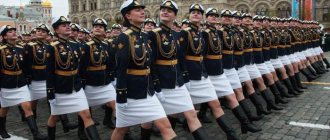“Leibstandarte SS Adolf Hitler” is the famous SS division, the first of them. Legends were made about the tenacity of the fighters of this unit (tirelessly inspired by official propaganda). There were 58 holders of the Knight's Cross alone in the Leibstandarte. Nevertheless, it was this elite military unit that received the derisive nickname “asphalt soldiers.”
The history of the most famous Waffen-SS formation began in 1933. In March, the Berlin Staff Guard (Stabswache), later renamed the Zossen Sonderkommando, numbering three companies, was created from racially impeccable and loyal to the Fuhrer general SS fighters. In June, another sonder team appeared, the Uttenborg team, which also carried out security functions.
Adolf Hitler SS. Fuhrer's personal guard
In 1933, the leader of the NSDAP and the new Chancellor of Germany, Adolf Hitler, was able to afford a large permanent security detachment - 117 people. He was recruited from among the SS members. The detachment was led by Hitler’s bodyguard, Joseph “Sepp” Dietrich.
Recruitment continued: in just a few months, this unit, called the “Special SS Command “Berlin”, reached a strength of 600 fighters. And then it grew to the size of a regiment, which received the name “Leibstandarte SS Adolf Hitler” and became motorized.
The requirements for recruits were then serious: age from 23 to 30 years, height from 184 cm, excellent health, Aryan origin, loyalty to the National Socialist ideology. The selection was strict.
In the summer of 1934, Dietrich’s subordinates carried out reprisals against Ernst Roehm’s supporters who were disloyal to Hitler, shooting dozens of people without trial.
Leibstandarte in 1935
Otherwise, the Leibstandarte was a typical ceremonial military unit, in which most of the time was devoted to drill and drill. The ideological indoctrination of personnel was also much stronger than usual.
Soldiers and officers of the Leibstandarte performed ceremonial and guard functions: parades, guards of honor, guarding government and party institutions, residences, ensuring the security of Berlin airports, personally of Adolf Hitler and other high-ranking Nazis.
Training until you sweat and exam with the marshal
0
The commander of the combined battalion Vovk took part in two parades - on November 7, 1941, he also marched along Red Square. Many years later, Vovk recalled that instructions on how exactly to throw the banners were given to him by the military commandant of Moscow, Kuzma Sinilov. And clearly - he went out into the yard with the senior lieutenant, picked it up and forcefully threw a pre-prepared two-meter wooden tent spreader. The front-line soldiers who were included in the “team of trophy banners” recalled that they were driven in training like recruits - during the battles they had forgotten their drill training. The great joy of Victory helped me endure. On June 21, 1945, that is, the day before the parade, Marshal Zhukov personally inspected the group’s readiness. The formidable military leader was pleased with everything and gave the go-ahead for the ceremony.
Participation of the Leibstandarte SS "Adolf Hitler" in the European campaigns of the Wehrmacht
But the Fuhrer wanted his personal guard not only to engage in shagistics, but also to participate in all, without exception, conquests of the Third Reich. He attached considerable propaganda importance to this.
Therefore, Leibstandarte units attached to the Wehrmacht motorized corps entered the Saarland and the Rhine demilitarized zone; annexed Austria (where they were tasked with occupying the Fuhrer's hometown of Linz) and the Sudetenland; participated in the occupation of the rest of Czechoslovakia.
By the beginning of World War II, the Leibstandarte SS Adolf Hitler was a reinforced motorized regiment, the equipment of which would be the envy of other similar units.
Sepp Dietrich rewards his subordinates.
France, 1940 During the invasion of Poland, he was included in the 13th Army Corps of von Weichs, and one battalion remained in Berlin. In the very first real battles, the Leibstandarte showed its inconsistency, was removed from the front and sent to clean up the occupied territories.
An incident occurred with the Leibstandarte during the capture of Holland, where it operated as part of the 9th Panzer Division advancing on Rotterdam. The soldiers did not understand that the city had already been taken by German paratroopers led by Kurt Student, and fired at the surrendering Dutch soldiers. At the same time, General Student was also seriously wounded.
Belgium, France, Yugoslavia and Greece - everywhere the Leibstandarte SS Adolf Hitler regiment took part in the seizure of territories, after which they paraded through the streets of the largest of the occupied cities. In August 1940 it was increased to the size of a brigade (motorized).
"Blonde Giants"
The Leibstandarte carried out guard duty in the Imperial Chancellery, the residences of the Fuhrer and Reichsfuhrer in Berlin, ensured the security of other strategic sites, and took part in numerous parades. Dressed in an impeccably fitting black uniform, Dietrich’s well-trained “blond giants” accompanied the top officials of the state on all trips and greeted foreign ambassadors. The number of units grew, its functions expanded. By 1935, the LAS had become a motorized regiment of 2,660 people. Close attention was paid to the political training of fighters: along with sports activities and stepping, members of the Arab League attended ideological lectures several times a week. The personal life of the Fuhrer’s “black guards” was also subject to racial laws. Before marriage, a member of the Leibstandarte was required to provide for verification not only the documents of the bride’s ancestors, but also a photograph of her in a bathing suit: the girl had to fully comply with Aryan ideals. The exclusivity of the Leibstandarte was evident in everything. Accommodation in the best barracks in the Lichterfelde area, the best supplies and conditions of service. Members of the LAS, the only ones of all SS units, wore white belts and sword belts with the standard SS uniform. Another insignia was the 28mm cuff bands on the left sleeve: the handwritten inscription “Adolf Hitler” embroidered with aluminum thread, as well as sleeve patches with the monogram “LAH”. Joseph Dietrich's general's cap had gold trim and strap instead of the standard silver. The unit's tactical emblem is also associated with its first and most famous commander. The image of a master key on the heraldic shield indicated the ability of the LAG to cope with any task. In German, the word “master key” is consonant with the surname Dietrich. After "Sepp" Dietrich received the Oak Leaves for his Knight's Cross, a wreath of oak leaves appeared on the emblem. Such is the symbolism. The mutual hostility between the Wehrmacht and the SS could not but affect the Leibstandarte. Thus, the Fuhrer’s guardsmen were nicknamed “asphalt soldiers” because of the color of their uniforms and the excessive attention of the command to drill training. They say that this parade and ceremonial unit in beautiful uniform is inferior to the army in military and physical training. It even got to the point of refusing to salute each other and even clashes with assault! The officers of the old Kaiser school, who came from noble families with a rich pedigree, looked at the upstart Dietrich with poorly concealed contempt. The proud Dietrich, who in the depths of his soul also despised this entire military aristocracy with its class-caste spirit, was irritated by fair criticism of his beloved brainchild. Reichsführer Himmler too. Therefore, in 1936, the 1st (Operational) Directorate (Fiihrungsamt) as part of the SS Main Directorate was headed by Paul Hausser, a retired Wehrmacht lieutenant general. Hausser was given the broadest powers and given a specific task: to create an effective military training system for SS recruits, to make them trained and persistent fighters. Of course, the Leibstandarte played a leading role. As a result, military training was as close as possible to real conditions using real artillery and live ammunition. Accidents and even losses were common. Himmler looked at this philosophically: the SS men had to take other people's lives and give their own without hesitation.
"Adolf Gitler". SS division in 1941-1945.
After the invasion of the USSR, the Leibstandarte brigade took part in the Wehrmacht's offensive operations in Ukraine. Including - surrounded by Soviet troops near Uman, during the capture of Kherson. During 1.5 months of combat operations, the brigade lost more than half of its equipment. Personnel losses were much greater than during the European campaigns.
However, after a short respite and replenishment, the brigade was again sent on the offensive: Zaporozhye - Taganrog - Rostov-on-Don. By the end of 1941, the brigade was almost completely destroyed: the personnel in it was almost 100 percent renewed. At the same time, the shortage in units remained 50 percent even after replenishment.
Column of SS Leibstandarte tanks
But in January 1942, it was decided to expand the Leibstandarte again: now to the size of a motorized division, with a staff strength of 22 thousand people. The formation was carried out in Germany, after which the renewed SS division “Leibstandarte SS “Adolf Hitler” was transferred from the Eastern Front to a calmer place for six months - to France.
In December 1942, a new return to the USSR and battles in Ukraine, near Kharkov, awaited her. Despite the fact that the SS division “Leibstandarte “Adolf Hitler” was listed as motorized, it had no less armored vehicles than the tank division - 190 tanks and assault guns.
At the end of July 1943, it again departed to the west - this time to Italy, where in October of the same year it became known as the 1st SS Panzer Division Leibstandarte SS Adolf Hitler.
In November 1943, she was again transferred to the Eastern Front, to the Zhitomir region. There, the Leibstandarte was used as a “fire brigade”, plugging gaps in the broken front line. Losses in personnel and equipment again became very large, and then reached catastrophic proportions.
Leibstandarte soldiers on Tiger tanks
In March 1944, the division found itself surrounded near Kamenets-Podolsky, from which it was able to escape only at the cost of huge losses - more than 90% of its personnel. Out of 227 tanks, only 3 came out of the cauldron. These pitiful remnants of what was called the Leibstandarte Adolf Hitler Division arrived in Belgium for reorganization. In fact, it had to be recreated anew, recruiting everyone. And still, the personnel shortage was at least 25%.
Propaganda Leibstandarte "Adolf Hitler"
Until February 1945, the newly formed division operated in Normandy against the Second Front of Anglo-American troops, then it was sent to Hungary and Austria, where on May 8, 1945, the “Adolf Hitler” division surrendered to the Allied forces.
Roman tradition, practice of Suvorov
0
See all photos in the gallery
The Victory Parade in June 1945 was carefully thought out; every element of it had to remain in history. Something was needed that could remain in people's memory, even decades later, as a vivid memory of the final point in the fight against Nazism.
0
It is difficult to say who exactly came up with the idea of throwing fascist banners at the foot of the Mausoleum. According to one version, the Soviet historian Yevgeny Tarle reminded Stalin of the Roman tradition of throwing the banners of a defeated enemy at the feet of Caesar or the victorious commander. General Sergei Shtemenko, who actively participated in the preparation of the Victory Parade, argued that he heard the idea with banners and standards from Stalin, who said: “Hitler’s banners must be brought to the parade and thrown in shame at the feet of the victors. Think about how to do it."
0
It cannot be said that this was new to the Russian military tradition. The great Suvorov practiced the “execution” of captured banners as an act of “disregard not for the enemy, but for his defeated military distinctions.” The idea, however, was quite complex. The ceremony required careful planning so that everything did not turn into a dump and a crush - the military personnel had no experience of such reorganizations.
Links[edit]
Quotes [edit]
- ^ a b Cook, Stan and Bender, R. James. Leibstandarte SS Adolf Hitler
, R. James Bender Publishing, 1994, pp. 17, 19. - Reynolds page 6.
- Reynolds
- Reynolds page 2.
- Reynolds page 4.
- Jump up
↑ Reynolds, pp. 288-291.
Bibliography[edit]
- Cook, Stan and Bender, Roger James. (1994). Leibstandarte SS Adolf Hitler: Uniform, Organization and History
, San Jose, CA: R. James Bender Publishing. ISBN 978-0-912138-55-8. - Reynolds, Michael (1997). Steel Inferno: I SS Panzer Corps in Normandy
, Spellmount. ISBN 1-873376-90-1.

